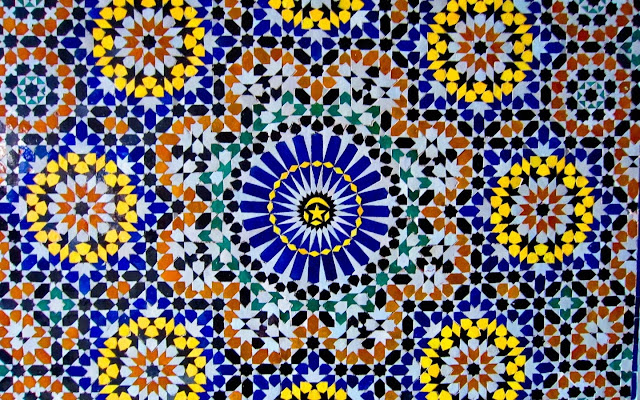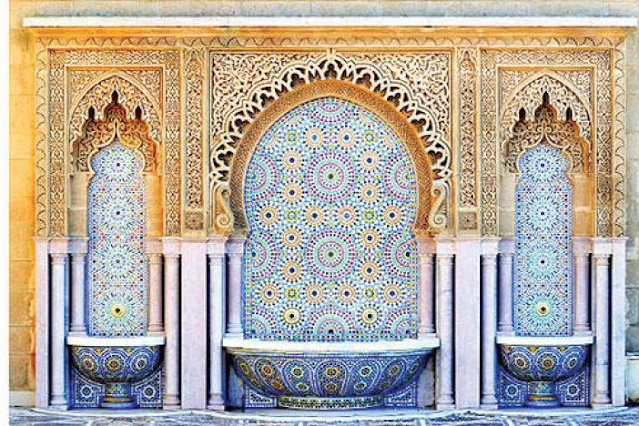Zellij, a traditional Moroccan tilework, is more than just a beautiful decoration – it's a celebration of cultural heritage, community collaboration, and sustainable design. In this article, we delve into the mysteries of Zellij, exploring its history, significance, and unique production methods. From the intricate patterns and designs to the natural materials and traditional techniques, we uncover what makes Zellij a true masterpiece of Moroccan culture. Join us on a journey through the world of Zellij and discover why this stunning art form is taking the world by storm.
What is the significance of the Moroccan "Zellij" or traditional tilework?
Morocco is known for its stunning architecture and rich cultural heritage, and one of the most iconic elements of Moroccan design is "Zellij," or traditional tilework. Zellij is a type of mosaic that uses small, hand-cut tiles to create intricate patterns and designs that adorn walls, floors, and other surfaces.
Firstly, Zellij has a long history in Morocco, dating back to the 10th century. It was initially used in religious buildings such as mosques and madrasas, where it was believed that the intricate patterns and designs helped to create a serene and meditative atmosphere. As the art of Zellij evolved, it began to be used in a wider range of buildings, including private homes and public spaces. Today, Zellij is still widely used in Moroccan architecture, and it is a testament to the country's rich cultural heritage.
Additionally, Zellij is significant in Moroccan culture because of the skill and craftsmanship required to create it. Each tile is hand-cut and carefully placed to create the desired pattern, a process that can take weeks or even months to complete. The artisans who create Zellij are highly skilled and often have years of experience, passing down their knowledge and techniques from generation to generation. This makes Zellij not just a beautiful art form but also an important part of Moroccan cultural heritage.
Moreover, Zellij is also significant because of the materials used to create it. The tiles are made from natural materials such as clay and natural pigments, which are sourced locally. This not only gives Zellij its distinctive earthy tones but also makes it an environmentally friendly option for building and design. In a world where sustainability is becoming increasingly important, Zellij is a great example of a traditional art form that is both beautiful and eco-friendly.
Furthermore, Zellij has become a symbol of Moroccan identity and pride. The intricate patterns and designs are instantly recognizable as Moroccan, and they are often used in branding and marketing to promote the country's cultural heritage. Zellij has also become a popular souvenir for tourists visiting Morocco, with many shops selling small pieces of Zellij as a way to take a piece of Moroccan culture home with them.
Than just a decorative element, Zellij is a testament to the creativity and ingenuity of Moroccan artisans. The intricate patterns and designs are a visual representation of the country's history, culture, and traditions. Zellij also plays an important role in preserving Moroccan heritage, as it requires a great deal of skill and knowledge to create. By continuing to use and promote Zellij, Moroccans are ensuring that their cultural heritage will be passed down to future generations.
Additionally, Zellij is a versatile art form that can be used in a wide range of applications. From grand palaces and mosques to small, private homes, Zellij can be customized to fit any space or design aesthetic. It can be used to create simple, understated patterns or bold, intricate designs that demand attention. This versatility makes Zellij an incredibly valuable tool for designers and architects who want to incorporate a touch of Moroccan culture into their projects.
Zellij is also significant because of the sense of community it fosters. The creation of Zellij is a collaborative effort, with each artisan contributing their unique skills and knowledge to the finished product. The process of creating Zellij is often a social event, with artisans gathering together to share stories and techniques as they work. This sense of community is an important part of Moroccan culture, and Zellij serves as a reminder of the importance of working together to achieve a common goal.
As we have explored, Zellij is a truly unique and significant aspect of Moroccan art and design. Its intricate patterns and designs are a testament to the creativity and ingenuity of Moroccan artisans, while its versatility and sustainability make it an incredibly valuable tool for designers and architects. Additionally, Zellij serves as an important reminder of the importance of community and collaboration in achieving common goals.
For those who are interested in incorporating Zellij into their own projects, there are a few things to keep in mind. First, it is important to work with skilled artisans who have experience in creating Zellij. This will ensure that the final product is of the highest quality and that the traditional techniques and methods are respected and preserved.
Also, it is important to choose a design and pattern that fits with the overall aesthetic of the space. Zellij can be customized to fit any design style, from traditional Moroccan to modern and minimalist. By choosing a design that complements the space, you can ensure that the Zellij is a cohesive and integrated part of the overall design.
Iit is important to consider the environmental impact of using Zellij. Because it is made from natural materials and requires no harsh chemicals or processes, Zellij is a sustainable and eco-friendly choice for those who are concerned about their impact on the environment. By choosing Zellij over other, less sustainable materials, you can help reduce your carbon footprint and promote a more sustainable future.
Therefore, if you are looking for a unique and sustainable way to add a touch of Moroccan culture to your home or project, Zellij is the perfect choice. By working with skilled artisans, choosing a design that complements your space, and considering the environmental impact of your choices, you can create a beautiful and sustainable design that will stand the test of time.
Moreover, the significance of Zellij extends far beyond its aesthetic appeal. It is a reminder of the importance of community and collaboration, as well as a celebration of Morocco's rich cultural heritage. Whether you are admiring the intricate patterns and designs or reflecting on the history and craftsmanship behind them, Zellij is a true masterpiece that deserves to be celebrated and preserved.
In conclusion, the significance of Zellij cannot be overstated. Its intricate designs, rich history, and sustainable production methods make it a true masterpiece of Moroccan culture. Whether you are a designer, architect, or simply an admirer of beautiful art, Zellij is a must-see. By incorporating this stunning tilework into your own projects, you can help support traditional artisans, celebrate cultural diversity, and create a unique and sustainable design that will stand the test of time. So if you are looking for a way to add a touch of Moroccan beauty to your life, consider Zellij – you won't be disappointed.



